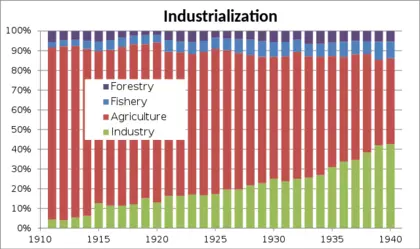During the annexation of Japan and South Korea, the Korean Peninsula modernized and achieved economic growth. This is contradictory data from the South Korean government, which does not want to admit
2021-12-30
Category:Annexation of Japan and Korea I'm participating in the ranking.Please click and cheer for me.
Japan-Korea annexation as seen from data released by the Korean government
This is the actual state of the Korean peninsula during the annexation of Japan and Korea, as published by the Korean Statistical Office.
Number of doctors: increased approximately 7 times
Number of deaths due to infectious diseases: Significant decrease
Water supply amount: increased approximately 4.8 times
Number of kindergartens: approximately doubled in 10 years
Child protection business: Increased approximately 4.3 times
Number of public elementary schools: increased approximately 7.5 times
Population: Increased approximately 1.8 times
The number of robberies has significantly decreased, etc.
MEMO During the Japanese colonial period, the Korean peninsula experienced significant economic growth and was on the path to modernization.
It was not a time of enslavement, but a time when people felt a sense of enrichment in their lives
South Korea has complained to the international community that it was annexed by Japan, enslaved, and massacred, but its population appears to be increasing.
Read it together
Geographically, the Korean Peninsula is covered by the Chinese continent, and successive Korean dynasties have become vassal states - What is Japan's position from the perspective of the continental p
Geographically, the Korean Peninsula is covered by mainland China
A vassal state of China since its founding
Korea continues to be invaded by China
China and Korea were ruled by different ethnic groups
Seeing history from the perspective of northern peoples
South Korea only denounces Japanese rule
The Korean Peninsula has a history that is inseparable from China, as the peninsula's geographical characteristics make it look like it is completely covered by the Chinese continent.
What exactly is this sense of victimhood and hostility toward Japan that Korean people have? The historical differences between China and Japan seen from South Korea are largely due to geopolitical reasons as seen from a map, but that is not the only reason. I would like to think about it in terms of the dominant ethnic group and the ruled ethnic group.
Legend has it that there were countries called Dangun Joseon and Minojo Joseon, but archaeologically it is said that they existed from the later Eishi Joseon.
The legendary Mino Korea is said to have been founded by the Mino of the Shang Dynasty in China, and the Wei Dynasty Joseon is said to have been founded by the Wei clan of the Yan Dynasty in China. Both were founded as vassal states of China.
After that, Goguryeo, Baekje, and Silla entered the Three Kingdoms period, and then the Sui Dynasty invaded Koguryo, and the Tang Dynasty invaded Koguryo.
Although Goryeo established a unified dynasty, it was placed under the control of the Later Tang Dynasty shortly after its founding. During the Yuan Dynasty, China was invaded by the Mongol Empire and became a vassal state. The Allied Forces of Mongolia and Goryeo invaded Japan twice, but failed.
Lee Seong-gye, who founded the Joseon Dynasty, is also known as the Jurchen people, and the Jurchen people were an ethnic group that lived in the Manchuria region, and later Hong Taiji founded the Qing Dynasty in China.
From China's point of view, the Korean people are recognized as a different ethnic group living outside the Great Wall of China, and these ethnic groups lived primarily as nomadic peoples, but due to the geographical relationship of the peninsula, the Korean people have decided to settle down. It seems that it has become.
Northern ethnic groups such as the Xiongnu, Xianbei, Khitan, Jurchen, Manchu, and Mongolians were a threat not only to the Han Chinese in China, but also to the Koreans.
Looking at the history of China, there have been only a handful of unified dynasties founded by the Han Chinese, who make up the majority of the country, and for most of its history, different ethnic groups have ruled the Chinese mainland.
When I look at world history, I have never seen a history centered on northern peoples, but if I dare to look at it from that perspective, both China and the Korean peninsula were invaded and dominated by northern peoples.
The Sui, Tang, and Yuan dynasties that invaded the Korean Peninsula mentioned above are different ethnic states in China if you consider them centered on the Han people. It is also a country of different ethnic groups when viewed from the perspective of the Korean Peninsula.
In addition to small-scale direct invasions by foreign ethnic groups, the majority of the history of the Korean peninsula is that they invaded the peninsula after taking control of mainland China.
In this composition, Japan is classified as one of China's peripheral ethnic groups. Geographically speaking, Japan is called Toi in contrast to Northern Yi. They are a neighboring ethnic group common to China and the Korean Peninsula.
If we look at the annexation of Japan and Korea in the above sense, it means that the Korean peninsula was ruled by a different ethnic nation that also shared China. It is also a foreign country to China.
Some people point out the contradiction in that Koreans do not complain about the fact that they were ruled by China for over 1,000 years, but they hold a grudge against Japan for 1,000 years only for 35 years, but in reality, the country of China itself is the same. I wonder if there is a complicated background to the history of a controlled area.
Historically, Japan may still be recognized as a common enemy of China and the Korean Peninsula.
It is said that South Korea's sense of victimhood is something that has been cultivated historically, but if you look closer at the globe, you can see that mainland China has also had a history of being invaded. Based on this, Japan should resolutely clarify its position.
The period of annexation between Japan and Korea is approximately 35 years. The reasons why the population increased 1.8 times during this period include maintaining public order, improving medical care, and reducing poverty.
Public order is maintained through laws, police, and the spread of education, and medical care is achieved through the addition of medical personnel and the provision of medicines, medical equipment, and other supplies.
Reducing poverty requires increasing employment through the creation of many jobs and improving the food situation. Japan's social improvements in all of these areas resulted in population growth.
POINT Even though this data is published by the South Korean government itself, the country as a whole is repeating completely contradictory claims.
I'm participating in the ranking.Please click and cheer for me.
Korean Empire It is strange to call the emperor king, saying that the Chinese emperor is the only emperor, that the Korean Peninsula is a king, and that Japan is king.Japan is not originally a subject of China.The Korean Empire was founded after the Sino-Japanese War. King Gojong said we are no longer a subordinate country to China, so it needs to have the title of emperor.That's why it's the Korean Empire.Although it was under Japan's protection, Japan approved it.The Emperor's Imperial Rescript, which led to the annexation of Japan and South Korea, also states that he is the Emperor of Korea.
History closed due to the abolition of kanji - Korean education that does not know history and cannot read history.
In South Korea, it is said that if you don't know history, you won't be able to become a fine adult. History is one of the subjects in Japan, and many science and math students don't like history and don't study it much. At least I don't think that I can't become a fine adult.
There is a question as to whether Koreans are actually interested in history. The problem, rather than differences in historical understanding, is the method of approach. It is said that the Korean peninsula was colonized by Japan, but it is strange why we do not learn about the history of the development of the Korean peninsula. History is all about learning both sides, but in South Korea, only the story of being ruled and oppressed appears.
Who are the Japanese who introduced history, civil engineering, engineering, chemistry, medicine, and various other social infrastructures and social systems, and what kind of person is that person? Although these things remain as historical facts, they are never adopted in history and are dismissed. Would it be possible to learn history without learning that? The best approach to studying history is to look directly at the Korean Peninsula of that era and think from that perspective.
They only shout that they were ruled by Japan, but the facts that developed during that time are hidden. History education is about learning both.
What about Japanese rule in Asia? If you compare the colonial forms under Japanese rule in Taiwan, Indonesia, Malaysia, Palau, Vietnam, etc., you should be able to see the Japanese style of colonial management at the time, but it seems that South Korea does not have that perspective. There doesn't seem to be any.
Speaking of colonies, what is the difference from Western colonies? When did it start and what process did it take to spread to Asia? Even though they are called Western countries, Britain, France, and the Netherlands have different colonial management styles. The concept of history that South Korea presents to Japan is fixed and does not have a multifaceted perspective. It is a one-dimensional understanding of history that begins with Japanese rule, and since even China does not enter into it, it is not Oriental history either. Or even seen as creative history.
Materials from the Japanese colonial period are kept in Japan. Of course, it was written in the Japanese of the time. Minutes and resolutions are public documents and can be viewed by the general public. This means that the information is accessible even to Koreans who can read Japanese. In order to understand the Japanese colonial period, Korean historians should have access to it, but this is not the approach at all. So when you ask them what kind of materials their historical claims are based on, nothing comes out.
I wonder if there are any historians in Korea who can't read kanji? South Korea abolished kanji in 1970, and the generations after that were unable to read kanji. If you can't read kanji, you won't be able to read history from the Japanese colonial period or even before that.
The abolition of Chinese characters is also greatly involved in Korean historical awareness. If you can't read kanji, you won't even be able to access past documents.
Ahn Jung - geun didn't know Ito' His autobiography shows that Ahn did not know Ito's face.How did you know that Ito Hirobumi, who didn't even know his face, visited Halpin Station at that time on October 26, 1909?
--The last page of Ahn Jung-geun's autobiography--
First, he fired at an old man with a yellow face and a beard.
I don't know Ito's face, so if I mistake him for someone else, it's big blunder, so I fired at the most dignified person.
Syngman Rhee disliked Japan and rewrote history; repeated purges to make the current government a "better government".
After the war, the thing that the South Korean government hated most was the phrase, ``The Japanese era was better.'' In fact, the February 28 Incident occurred in Taiwan, causing pro-Japanese groups to riot, and former President Syngman Rhee must have been alarmed after hearing about the incident. 2.28 Incident occurred in 1947, and the Republic of Korea was founded in 1948. Martial law was imposed in Taiwan for 38 years.
Immediately after the founding of the country, pro-Japanese groups were expelled. Just because they were nostalgic for the Japanese rule, they were treated as political prisoners, like communists, and were arrested and imprisoned. In just two years since the founding of the country, the number of arrests has exceeded the number of people arrested during the 35 years of Japanese rule.
Syngman Rhee, the first president of the Republic of Korea, did not actually know anything about Japanese rule, as he spent most of the time abroad. However, he hated Japan. During the time when Syngman Rhee was in exile in the United States, Joseon was even advertised as an ``ideal oriental nation'' before Japanese rule.
Although Japanese rule had ended in Taiwan, the Kuomintang army led by Chiang Kai-shek arrived there, and their politics were terrible. Even though Japanese rule has ended in South Korea, there is no guarantee that the country will be able to be run successfully.
Since the people who were involved in the management of the country during the Japanese colonial era were expelled one after another as remnants of the Japanese Empire, a group of amateurs with no political experience were left in charge of political administration. In addition, many purges and massacres of communists have been carried out due to concerns that they may collude with North Korea and aim to overthrow the country.
For the Republic of Korea, which was established as a military regime, those who could pose a threat to the management of the country were those who were pro-Japanese and communists. While they were hysterically eliminated, anti-Japanese language was also used to deflect criticism of the government's mismanagement, such as the Bodo League Incident, the Jeju April 3rd Incident, and the National Defense Force Incident. /red#.
Bodo League Incident A massacre that took place at a facility that re-educated communists and their families.
Jeju Island April 3 Incident A massacre was carried out in response to a riot that occurred on Jeju Island in South Korea, which is under the control of the United States Army Headquarters Military Government Agency.
National Defense Force Incident In January 1951, during the Korean War, executives of South Korea's National Defense Force Headquarters stole military supplies, food, and rice supplied to the National Defense Force. Embezzled. It is said that over 90,000 Korean soldiers starved to death due to embezzlement.
Past history has also been rewritten. Since Syngman Rhee himself had no knowledge of the Japanese colonial period, it could be said that it was easy for him to rewrite history.
The historical view that the Korean peninsula was exploited and enslaved during the Japanese colonial period creates an imaginary "better government" in which even if domestic politics does not go well after the founding of Korea, it will be much better than the Japanese colonial period. I created it .
In order to make that view of history into social norms, even affirming Japanese rule would become a political prisoner. The most problematic thing is that such conventional wisdom and education are still being inherited today.
Emperor Sunzong's imperial admonitions and the truth about the annexation of Japan and Korea.A life spent playing billiards as a hobby and listening to the gramophone at night.
In 1909, the movement for the annexation of Korea and Japan became stronger, and Prime Minister Lee Wan-yong, with the support of pro-Japanese groups such as Iljin-kai, proceeded to discuss the annexation of Korea with the Japanese government. On August 22nd, the Japan-Korea Annexation Treaty was signed.
On August 29th, the treaty came into effect with the approval of the emperors of both countries, and the Korean Empire collapsed and came under the control of the Japanese Governor-General of Korea. The following is an imperial admonition issued by Emperor Sunjong, the last emperor of the Joseon Dynasty, to the Korean Peninsula, and was also published in newspapers.
Imperial admonition of Emperor Sunjong of the Korean EmpireI have done a tremendous amount of work and have striven for the Restoration ordinance from my accession to the present day. The road ahead is still steep, the country is weakened, and exhaustion is everywhere, leaving us at a loss. This situation cannot be brought to an end. Rather, we should entrust them with great responsibilities and obtain perfect methods and innovative achievements. For this reason, I have personally decided to transfer the right to govern Korea to His Majesty the Emperor of Japan, a neighboring country, to solidify peace in the East and ensure the life and safety of the Korean people. The people should deeply understand the state of the country and the times, work without confusion, submit to the new civilized government of the Japanese Empire, and enjoy its happiness. I have never forgotten the people. It was born out of the true intention of saving and making use of the people, so please understand this well.August 29, 1910
After the annexation, Sunjong (Lee Ben) lived in Changdeokgung Palace in Gyeongseong-fu, was established as a king, and was called ``King Yi.'' Before the annexation, he was so weak both mentally and physically that he was unable to walk without the support of his attendants, but by this time he was able to walk and began to respond cheerfully. Masatake Terauchi said that this may be because he was ``freed from the pain of national troubles.''
After his abdication, Sumjong lived a graceful life
``Li Wang'' was very nervous, and he checked his own clock to wake up, take a bath, and go to bed on time. He played his hobby of billiards from 2pm to 4pm on weekdays and listened to the gramophone at night.
Also, like his father Gojong, who became King Yi Tae, he had an excellent memory, and it is said that he never forgot the names of the people he had an audience with. He loved the French cuisine of Kaneyoshi Yoshikawa, the first head chef of the Imperial Hotel, and ate it almost every day.
In June 1917, he visited Japan and had an audience with Emperor Taisho, who had visited Korea 10 years earlier. In November, a fire destroyed most of Changdeokgung Palace, and they moved to the remaining building called Rakuseonjae, but it was too small.
Lee Wan-yong considered moving to Deoksugung Palace, where King Lee lived, but when Lee heard this, Lee reprimanded him and said, ``Don't move, it's Changdeok Palace given to you by His Majesty the Emperor.'' After that, he lived in Nakseongjae for two years until the restoration of Changdeokgung Palace was completed.
It is believed that Shirosuke Gondo, the administrative official of the King of Yi, believed that the rituals of the King of Lee would be preserved by the title of ``Changdeokgung''.
Korea claims that they were forced to annex Japan and Korea, but no matter how you look at Sunjong's imperial admonitions and his subsequent life and behavior, it doesn't seem that way.




